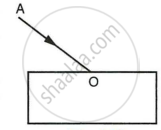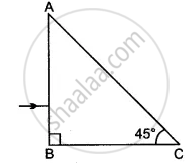Advertisements
Advertisements
Question
A ray of light passes from water to air. How does the speed of light change?
Solution
The speed of light increases as it passes from water to air.
APPEARS IN
RELATED QUESTIONS
Light passes through a rectangular glass slab and through a triangular glass prism. In what way does the direction of the two emergent beams differ and why?
How is the reflection of light ray from a plane mirror different from the refraction of light ray as it enters a block of glass?
In the adjacent diagram, AO is a ray of light incident on a rectangular glass slab.

- Complete the path of the ray till it emerges out of the slab.
- In the diagram, mark the angle of incidence (i) and the angle of refraction (r) at the first interface. How is the refractive index of glass related to the angles i and r?
- Mark angles of emergence by the letter e. How are the angles i and e related?
- Which two rays are parallel to each other? Name them.
- Indicate in the diagram the lateral displacement between the emergent ray and the incident ray. State one factor that affects the lateral displacement.
Four students showed the following traces of the path of a ray of light passing through a rectangular glass slab.

The trace most likely to be correct is that of student
(A) I
(B) II
(C) III
(D) IV
Name the material for which the refractive index is found to be maximum.
What is the refractive index of water
State the relation between the refractive index μ and the velocity of light (vm) in that medium.
Calculate the velocity of light in a glass block of refractive index 1.5. (Velocity of light in air = 3 × 108 m/s)

